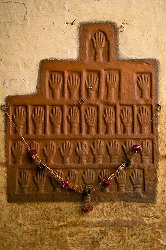If you want to be a righteous woman and avoid suppression and humiliation at the hands of tribesmen, you should burn yourself to death after your husband's death. If you fail to do this, you will suffer agonizingly from a merciless society.
It might seem that this is a trick or a sick joke, or an accusation of laxity in religion or morals. However, sati which is performed in
Indian society is distinguished by a variety of customs, traditions, languages, and religions which are mostly man made culture and civilization. Likewise, it is distinguished by eccentricities and unusual customs that are seldom found in other societies.
According to Vinod Raja, Professor of History at
Vinod Raja adds that Indian women in history would perform sati as a way of expressing sincerity and loyalty to their husbands, and also avoiding dishonor at the hands of King Karan Jawhar's invaders. They did so after their husbands' death in the battles against the soldiers of King Jawhar who invaded
Raja mentions that he does not know the origin of sati. However, sati is attributed to the Hindu god Shiva's wife. She immolated herself in front of the attendees expressing her discontent with her father Daksha. Her father organized a yagna for the great gods, but he did not invite Shiva. This attitude enraged her due to the humiliation that struck her husband when her father ignored him. She set fire to herself as a sacrifice for her husband.
Raja adds that the sati system, which appeared in the first and second century CE, was rejected by many sects in Indian society. All of their religious books did not approve of such a custom. They actually emphasized that a person should not burn himself to death in sacrifice for another, no matter who that person may be. Human life is sacred and is of value, whether male or female.
Holy Hindu books of the Vaishya class mentioned that sati was practiced in the interval between the first and the second century A.D. Widows would consider it an alternative if they could not live an honorable life after their husbands' deaths. Although the inhuman sati system was denounced among all circles by then, Mahabharata stories told that a woman called Madri immolated herself on her husband's funeral pyre in the sixth century CE.
Dr. Raja says that the sati system was practiced in the northern and southern states of
Sati was actually practiced when a husband died. His body was taken to the pyre, and his wife was ordered to put on her most elegant clothes and apply the best perfume she owned. She would follow the funeral procession in the company of her family until she reached the pyre.
Raja adds that the pyre was to be burned when the wife and her family arrived. The wife was ordered to sit next to the body of her deceased husband and bewail his death until she lost her senses. Afterwards, some men would tie her to the body of her husband, pour a highly flammable liquid over both of them, light a fire, and both husband and wife would be burnt to ashes.
Raja mentions that young girls who married at a very young age, mostly at ten, were not excluded from sati. They were to burn themselves to avoid dishonor after their husbands' death.
According to Hindu customs and traditions, widows had no right to remarry if their husbands died. Those who refused to perform sati were thrown into the fire by force as a punishment. If they tried to escape, they would be brought again and thrown into the fire. It was alleged that such women wanted to dishonor themselves and the tribe. Molten iron would be poured over these women so they would die pure and chaste.
If there is a lesson to be learned from this, it would be better learned by knowing the favor that Islam conferred on woman. Islam uplifted the status of woman, magnified her rights, protected her position, and emancipated her from every hackneyed tradition or thought. May blessing and peace be upon Prophet Muhammad who guided us to the Sharee‘ah and the straight path, for Allah The Almighty Says (what means): {And if you obey him, you will be [rightly] guided. And there is not upon the Messenger except the [responsibility for] clear notification.} [Quran 24:54]


 Home
Home Discover Islam
Discover Islam Quran Recitations
Quran Recitations Lectures
Lectures
 Fatwa
Fatwa Articles
Articles Fiqh
Fiqh E-Books
E-Books Boys & Girls
Boys & Girls  Women
Women










